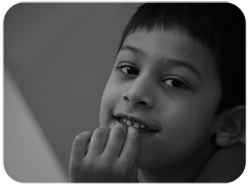ABA
What is Applied Behavior Analysis (ABA)?

Behavior Analysis is a science which explains the principles of how learning takes place. Based on these principles Behavior analysts have developed many techniques for increasing socially important behaviors, as well as developed strategies to reduce behaviors that might be harmful. Across decades of research these principles and techniques have been applied with many different kinds of learners in acquiring many different skills – from healthier lifestyles to the mastery of a new language.
Essential to both research and clinical practice of ABA is the measurement of progress through data collection so that an objective standard by which to measure progress is established.
Who practices ABA ?

Behavior Analyst Certification Board has set high & stringent standards for Professional Behaviour Analysts to practice application of behavior analysis principles in various settings. ABA practicing professionals engage in many hours of course work, field work and exams before working independently. Ongoing certification is maintained through the earning of continuing education credits from approved courses. Only through these processes can the high ethical and success standards set by the science be maintained.
How is ABA used to teach children with Autistic Spectrum Disorder?

Typically developing children learn skills such as language, play and social interaction without any intervention. The world we live in provides the right conditions for them to learn naturally. Children with Autistic Spectrum Disorder (ASD) and Developmental Delay also have potential to learn many skills but they find these much more difficult to learn from their environment.
Applied Behavior Analysis as an intervention teaches us how to create a motivating yet structured environment where conditions are optimized for the child with autism to learn so that they can acquire the same skills as typical children.
How are ABA principles practiced at BMI ?

The principles of ABA are used at BMI to create conditions necessary to maximizing learning;
- new skills are taught in such a way that learning is errorless and therefore rewarding for the student,
- skills are introduced systematically so that the students is confident with the prerequisite skills before being taught new skills,
- teaching targets are highly individualized and monitored daily through data collection to ensure progress is ongoing,
- positive behaviors are always rewarded and therefore increase,
- teaching is provided both in a structured setting, such as at a table with specially designed materials, and in the natural environment in which the skill will typically be used,
- data is taken and analyzed so as to determine when skills have been mastered so that rapid progress can be maintained.
- challenging behavior observed at the BMI center is monitored through functional assessment. In case it is required to do a functional analysis, a BCBA is directly involved in the FA. This is followed by a Behavior Intervention Plan (BIP) and staff training for the implementation of the plan to reduce challenging behaviors.
The ultimate goal of a behavioral approach to teaching children with Autism is that they will learn how to learn on their own from the natural environment. Applied behavior analysis is the process of systematically applying interventions based upon the principles of learning theory to improve socially significant behaviors to a meaningful degree, and to demonstrate that the interventions employed are responsible for the improvement in behavior (Baer, Wolf & Risley, 1968; Sulzer-Azaroff & Mayer, 1991).